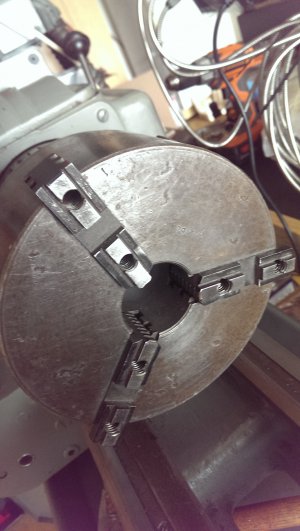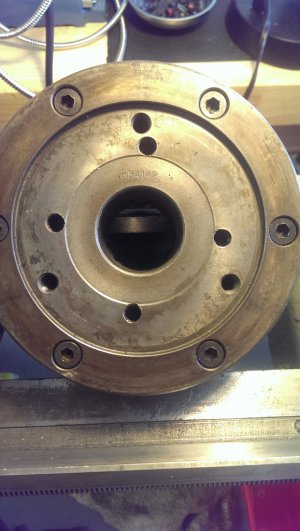Not sure that 'key pinion' is the right term but its the socket that the chuck key goes into to turn the jaws in or out. There are three sockets on my scroll chuck. Only need to use one of the sockets to open or close the jaws. It is recommended that each of the pinions be tried with a TIR measurement to see which socket gives the lowest result. Of course if a scroll chuck has only one key pinion this doesn't apply.
-
Welcome back Guest! Did you know you can mentor other members here at H-M? If not, please check out our Relaunch of Hobby Machinist Mentoring Program!
You are using an out of date browser. It may not display this or other websites correctly.
You should upgrade or use an alternative browser.
You should upgrade or use an alternative browser.
My Chuck, And The Saga Continues...
- Thread starter Joe Pitz
- Start date
- Joined
- Sep 29, 2014
- Messages
- 2,102
I use a set tru Bison 3 jaw scroll chuck nearly every day, 5-6 days per week, I change the top jaws several times per day on an average day. We have 40+ sets of soft jaws labeled for either recurring jobs or by diameter between 2 lathes.
Put the jaws on, chuck a piece of like sized material, (turn it so that is reasonably round first) indicate and adjust the chuck to whatever tolerance is required, expect .002-.005 TIR runout between parts as anything else is asking entirely too much of a scroll chuck. With practice adjusting the chuck will take less then 10 minutes unless you suffer from crippling OCD of course (-:
Put the jaws on, chuck a piece of like sized material, (turn it so that is reasonably round first) indicate and adjust the chuck to whatever tolerance is required, expect .002-.005 TIR runout between parts as anything else is asking entirely too much of a scroll chuck. With practice adjusting the chuck will take less then 10 minutes unless you suffer from crippling OCD of course (-:
- Joined
- May 7, 2015
- Messages
- 269
[QUOTE="
Put the jaws on, chuck a piece of like sized material, (turn it so that is reasonably round first) indicate and adjust the chuck to whatever tolerance is required, expect .002-.005 TIR runout between parts as anything else is asking entirely too much of a scroll chuck. With practice adjusting the chuck will take less then 10 minutes unless you suffer from crippling OCD of course (-:[/QUOTE]
Thanks Wreck Wreck, How do you adjust the jaws on a scroll chuck? Regardless of which chuck key hole I try to adjust, the TIR error is the same?
Joe
Put the jaws on, chuck a piece of like sized material, (turn it so that is reasonably round first) indicate and adjust the chuck to whatever tolerance is required, expect .002-.005 TIR runout between parts as anything else is asking entirely too much of a scroll chuck. With practice adjusting the chuck will take less then 10 minutes unless you suffer from crippling OCD of course (-:[/QUOTE]
Thanks Wreck Wreck, How do you adjust the jaws on a scroll chuck? Regardless of which chuck key hole I try to adjust, the TIR error is the same?
Joe
- Joined
- Dec 27, 2014
- Messages
- 4,058
Tozguy:
"Have you tried each of the key pinions to see which one gives the best TIR?" Not sure what that is?
Sometimes, each position where you can put the chuck wrench, can influence the run-out (TIR) differently. Put a dowel pin in the chuck and tighten it. mark the wrench position as No. 1, and check the TIR. Do the same for each position, compare and use the best one.
- Joined
- Sep 29, 2014
- Messages
- 2,102
[QUOTE="
Put the jaws on, chuck a piece of like sized material, (turn it so that is reasonably round first) indicate and adjust the chuck to whatever tolerance is required, expect .002-.005 TIR runout between parts as anything else is asking entirely too much of a scroll chuck. With practice adjusting the chuck will take less then 10 minutes unless you suffer from crippling OCD of course (-:
Thanks Wreck Wreck, How do you adjust the jaws on a scroll chuck? Regardless of which chuck key hole I try to adjust, the TIR error is the same?
Joe[/QUOTE]
You must have an adjustable chuck, you are adjusting the entire chuck body not the jaws themselves, Set Tru is a brand name owned by one of the chuck manufacturers, I am not sure which one.
Adjusting a set tru chuck is exactly like putting a scroll chuck in a 4 jaw independent chuck and dialing out the runout with the independent chuck, the errors in the scroll will remain however. If you require tenths accuracy dial in each part and finish it in one chucking, or stop chasing tenths (-:
I only chase tenths when I know that the Customer has the ability to measure it and the part requires it.
I routinely get drawings for lathe parts from one particular customer with dimensions like so (last weeks parts, a counterbore) .8749-.8744, .213 deep +- .002.
There is zero chance that anyone at this company can measure this, or would even try, chasing tenths will drive you mad so don't do it.
Last edited:
- Joined
- Sep 29, 2014
- Messages
- 2,102
An adjustable chuck has a loose fitting rabbet, (or register if you prefer that nomenclature) and 4 tapped screw holes arranged radially around the circumference, loosen the screws that hold the chuck body to the back plate, use an indicator on the part (in the jaws) and adjust the the 4 radial screws exactly like an independent 4 jaw chuck until you reach your required level of accuracy. Tighten the screws and machine away. Please note that these chucks will only correct .020-.030" of error, if more offset is required just use an independent chuck.Wreck Wreck, I am confused now. I will include some pics of my chuck. both front view and back view.
I do not think I have a Set Tru Chuck.
Thanks
Joe



